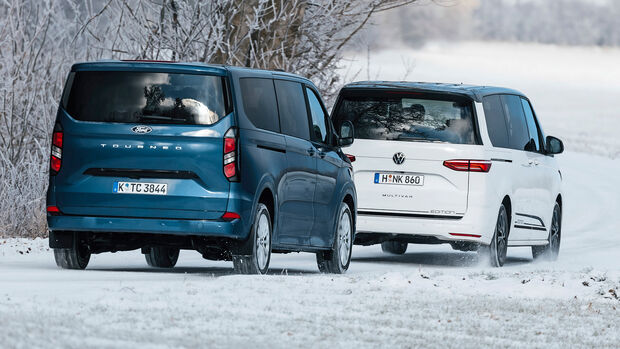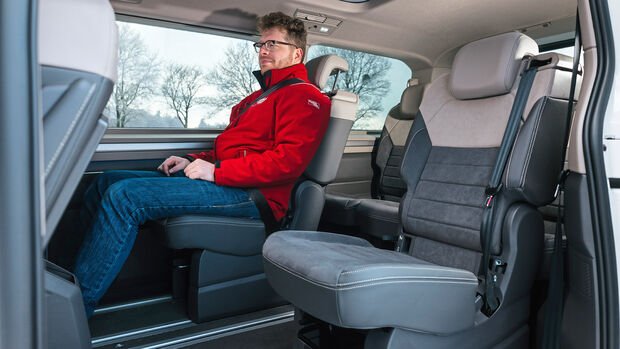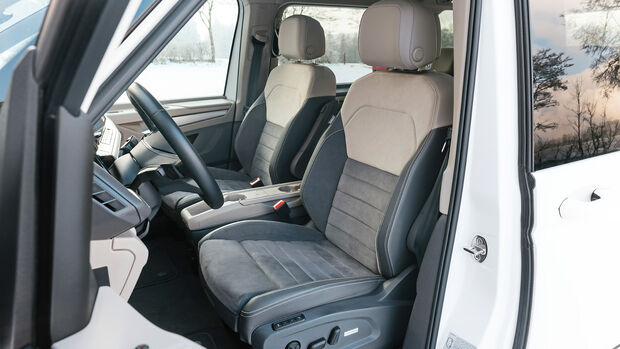Do you like it right now? The Bulli was always a VW bus and not a Ford Well, you’re right – or better yet: you were. In the future, the van version of the Bulli will be based on the Transit. And here it shows what it can do as a Tourneo civil custom.
Not all buses are the same. We put this understanding at the beginning of the comparison with the VW Multivan T7. Both are seen here with higher displacement diesel engines. But the difference is obvious at first glance: the Ford Tourneo not only exceeds the VW T7 in length, but also comes out almost half a meter from the standard parking space. Well, you can never have enough space. You of all people know this, dear recipients of many child benefits. After all, every time not only your own children, but also half of the football team have to be transported or Swedish furniture stores have to be looted. For such tasks, the Multivan alternative from Ford is a must, with a wheelbase of 3.50 meters to 5.45 meters and optionally carrying nine adults weighing 95 kg each.
For a Tourneo Custom bus driver, getting in means sitting down. However, through the steps you now climb into the interior more like a car. Well, it is made mainly of strong plastic, but it fits together without creaking – which is not a given in this class of car. The steering wheel, which is more square than round, sits very close to the front axle, but it fits well in the hand and provides a view of the digital instruments and a few displays that differ from the on-board computer.
The biggest feature is the 13-inch infotainment touchscreen in the center. Refreshing with the current Ford Sync 4 software, it is logically designed, wirelessly connects Android Auto or Apple CarPlay and executes voice commands faster than most pubescents. However, Ford largely avoids classic control buttons. All that remains is volume control. Larger tiles make the selection easier, but the direct climate control areas should be larger.
A small bus? Endless space!
Rossen Gargolov
The Tourneo Custom is available with two wheels (3.1 and 3.5 meters).
In addition to the electrically adjustable driver’s seat with lumbar support and two armrests for 922 euros, there are two pilots. Would you like to have some distance? Then save yourself the option of a middle seat, or simply fold down the middle back for extra storage space.
In fact, the family transporter has more distinguishing tricks: there are two glove compartments in front. Rear access is even easier with the optional sliding door on the left (774 euros). The three individual seats in the second row can be easily moved even by children and, with a little effort by adults, can be turned against the direction of travel without giving up the sleeping room. With the rear seat folded down, there is a table with a cup holder behind the middle seat. The third row is divided into two and can also be folded down very easily – but it can only be removed with a furniture mover. Even if all the seats are occupied, there is still plenty of room for luggage. Once all the rear seats are removed, there’s nearly seven cubic meters of cargo space and a payload of 861kg. Phew, the T7 can pack a punch. First you have to fully use about four cubic meters and 641 kilograms.
For Generation Z, there are enough USB-C ports on the back of the Ford behind the driver’s seat and on the C-pillar, as well as smartphone holders. Except for small compartments under the seats and energy drink holders, rear storage is limited. There are no bag hooks or parcel shelf in the trunk. Also silly: like the Bulli, the rear air conditioning module can only be accessed from the second row, and the optional glass roof panels don’t have roller blinds.
Ford: top tired diesel

Rossen Gargolov
The T7 Multivan consumes 6.5l/100 km of diesel on the Eco lap. In the test section is 8.2 l. The Tourneo Custom uses a better 7.3 liters, but on the highway it quickly reaches double figures.
Well, that’s a good prospect: Ford’s five-and-a-half-meter box is actually easy to see and steer with centimeter accuracy despite the wide roof pillars. However, cornering quickly requires courage, as the gymnasium-like structure changes and the steering offers little feedback. In addition, a 2.4-ton truck with “cargo” tires slows down from 100 kilometers per hour by 40 meters. T7, on the other hand, stops at an acceptable 35.6 meters. At least the Tourneo Custom offers its occupants suspension comfort thanks to the coil-sprung rear axle. The test car, which has the optional 19-inch wheels, rolls just a little on the curbs, but without any chassis rumble.
A top diesel with 170 hp works under the Ford hood. The two-liter starts admirably quickly in stop-and-go operation, but drives poorly and not only does it seem sluggish on top. Even unloaded, it takes 12.9 seconds to reach 100 km/h. From 130 km / h the wind breaks into two large mirrors and the propulsion continues to decrease visibly. The bus only reaches its top speed of 175 km per hour and long runs with a hurricane wind behind it also throws it off the track more easily.
On the highway, diesel consumption quickly climbs to double digits; With 9.9 liters in the 100 km test average, the transporter is not economical however. Especially since VW does it with almost two liters less in direct comparison. Yes, the T7 can be driven in everyday life almost as economically as a diesel station wagon (Eco round of 6.5 l/100 km). Value-wise, it accelerates a touch quickly on the test track and can set itself apart noticeably in the middle levels of the race. Is that not suitable for a family bus? Go on vacation fully loaded and get stuck behind a truck on a country road for miles because you don’t have enough power to pass it.
It is of little use that the feeling of Mercedes occurs in the Ford because of the selector lever directly behind the steering wheel. This will also allow you to change gears yourself. This will be important because of the usual lazy switching processes. But the subjunctive was chosen on purpose because turning the lever for manual shift operations is a problem because of space. In addition, there is a lot of shock in the drivetrain, especially when engaging gear D after a cold start.
Disabling the cruise control in five touch steps can also be equally annoying. It’s a good thing that Ford thought of a shortcut. A resident of Cologne usually interprets speed limits correctly and keeps a safe distance from other road users, even in heavy traffic. However, comfort support and flexible LED lighting on the Titanium cost more. At more than 62,000 euros, the test car is no bargain.
T does not stand for “transportation”

Rossen Gargolov
When turned against the direction of travel, there is less legroom in the VW in the back and less luggage space in the back than in the Tourneo.
Unfortunately, this is nothing new for minibuses. What is new, however, is that VW is pricing the T7 the same as the fully equipped version, but offering more options that easily push the price over 70,000 euros. In any case, no one should stop here anymore, so the driver is happy to change, but not to climb too high. You’re still sitting in the front row like a car, which is why visibility over the hood is as good as a Ford bus thanks to the open A-pillars. Additionally, the pilot and co-pilot move further into the center of the vehicle and sit in electrically adjustable, reclining seats with adjustable armrests.
VW puts the Multivan in corporate style: fortunately here with real buttons on the steering wheel, an open digital cockpit and a small but beautiful head-up display on the windshield that moves forward. To do this, the Hanoverians – who create the T7 – generously distribute the shelves and install an inductive charging station. In general, the quality is a whole league between VW and Ford, even if the colored plastics feel hard, especially at the back. How do you get there? Either through one of the two standard sliding doors, which optionally open electrically at the push of a button or – as possible – via remote control. Or you can squeeze between the front row seats, which we prefer. After all, it is very cold outside. An optional three-zone air conditioning system including heating in the test car helps to combat this.
Although the Multivan does not have a total of two seats, VW has created a children’s sports, dining and business section in the back with a movable table for 720 euros. In the back, everyone travels more easily in five individual seats, at least as long as all the seats are facing the direction of travel. Because in the face-to-face position, adults should arrange their legs properly. At least turning, removing or replacing the seating furniture is much easier and no longer requires precision tools to tap the seat rails, as was the case with its predecessors. The T7 is more practical: all seats have Isofix brackets and can be used as a shelf when folded down. The cargo space behind the third row of seats is divided by a compartment shelf; Bag holders, lower seat compartments and a removable flashlight make up for it. It’s just a shame that VW doesn’t offer any storage space for rear passengers.
VW: Van must be

Rossen Gargolov
In the Multivan, the pilot and his companions travel in comfortable seats almost like a car. This applies to the entire driving behavior.
VW has reinvented the Bulli in terms of driving dynamics. Because the T7 no longer drives like a transporter, but more like a car. It points more accurately, if not overly sensitive or accurate, it wobbles less and therefore rotates the pole faster. “Only” a car length of 1.9 meters, a width of 9 centimeters at the bottom and a turning circle without a width of 1.5 meters almost eliminate the fear of even the underground car parks of the old city. The same applies to deserted country roads: When unloaded, the T7 with its 17-inch winter wheels rumbles a little with the rear axle over the rolling joints, but overall it has a more balanced suspension, although VW had not installed a to fix. chassis on the test car. Travel comfort is also increased by better noise insulation, which also makes communication between the first and last row easier, while the Harman Kardon sound system, unlike the cheap Ford system, always plays the right sound of the environment.
Speaking of which: the 2.0-liter four-cylinder is impressively stocked. As is typical with TDIs, it struggles to shift quickly, but when it does, it’s better at holding onto the gas. The seven-speed DKG not only shifts quickly in the S position, but also accepts manual intervention via the shift paddles.
As in the Ford, the driving assistance takes the speed limits early into compliance. Thanks to Travel Assist, the T7 stays in its lane independently and, with navigation activated, even automatically descends to slower lanes at highway exits, which are well lit at night by the Matrix LED lights that come as standard on the Edition model.
So it’s clear who’s in the spotlight at the end, and so then who’s here.
| VW Multivan T7 version lang 2.0 TDI | Ford Tourneo Custom 2.0 L2 Titanium | |
| Base price | 61.555 € | 59.679 € |
| External dimensions | 5173 x 1941 x 1909 mm | 5450 x 2032 x 1993 mm |
| Transmission / engine | 1968 cm³ / 4-Cylinder | 1996 cm³ / 4-Cylinder |
| Performance | 110 kW / 150 HP at 3000 rpm | 125 kW / 170 HP at 3500 rpm |
| High speed | 190 km / h | 175 km / h |
| 0-100 km/h | 12.9 s | |
| consumption | 6.6 l/100 km | 8.0 l/100 km |
| Use of the test | 9.9 l/100 km |

























